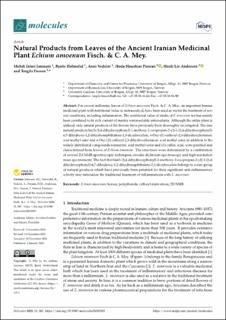Natural Products from Leaves of the Ancient Iranian Medicinal Plant Echium amoenum Fisch. & C. A. Mey.
Jamnani, Mehdi Jafari; Holmelid, Bjarte; Vedeler, Anni; Parsian, Hoda H.; Andersen, Heidi Lie; Fossen, Torgils
Journal article, Peer reviewed
Published version

Åpne
Permanent lenke
https://hdl.handle.net/11250/3055021Utgivelsesdato
2023-01-02Metadata
Vis full innførselSamlinger
- Department of Chemistry [433]
- Registrations from Cristin [9791]
Sammendrag
For several millennia, leaves of Echium amoenum Fisch. & C. A. Mey., an important Iranian medicinal plant with nutritional value as nutraceutical, have been used as tea for the treatment of several conditions, including inflammation. The nutritional value of intake of E. amoenum tea has mainly been correlated to its rich content of mainly water-soluble antioxidants. Although the entire plant is utilized, only natural products of the flowers have previously been thoroughly investigated. The rare natural products bis(3-(3,4-dihydroxyphenyl)-1-methoxy-1-oxopropan-2-yl)-1-(3,4-dihydroxyphenyl)-6,7-dihydroxy-1,2-dihydronaphthalene-2,3-dicarboxylate, 4-Oxy-(E)-caffeoyl-2,3-dihydroxybutanoic acid methyl ester and 4-Oxy-(Z)-caffeoyl-2,3-dihydroxybutanoic acid methyl ester, in addition to the widely distributed compounds rosmarinic acid methyl ester and (E)-caffeic acid, were purified and characterized from leaves of Echium amoenum. The structures were determined by a combination of several 2D NMR spectroscopic techniques, circular dichroism spectroscopy and high-resolution mass spectrometry. The fact that bis(3-(3,4-dihydroxyphenyl)-1-methoxy-1-oxopropan-2-yl)-1-(3,4-dihydroxyphenyl)-6,7-dihydroxy-1,2-dihydronaphthalene-2,3-dicarboxylate belongs to a rare group of natural products which have previously been patented for their significant anti-inflammatory activity may rationalize the traditional treatment of inflammations with E. amoenum.
